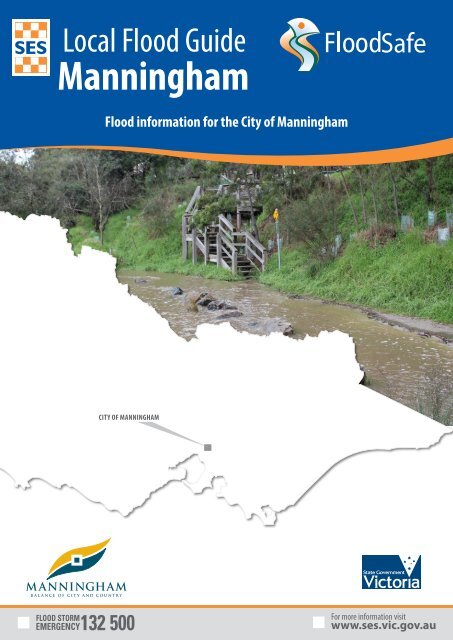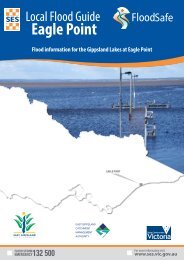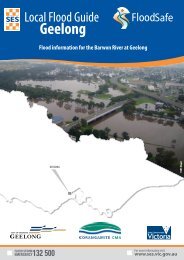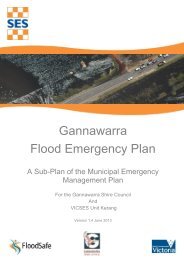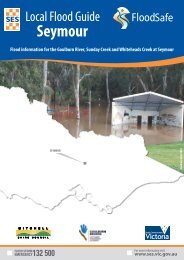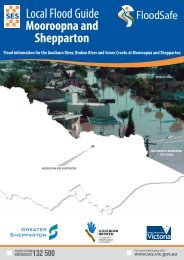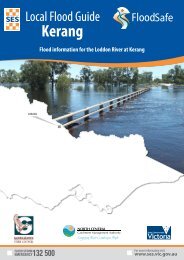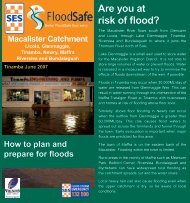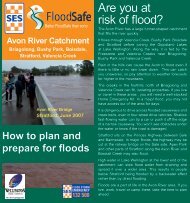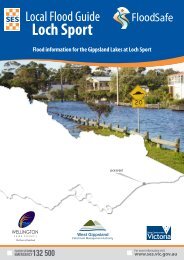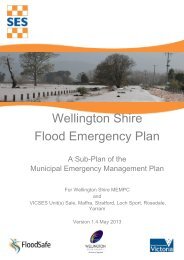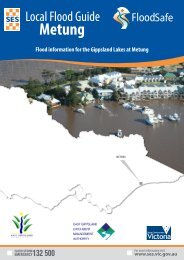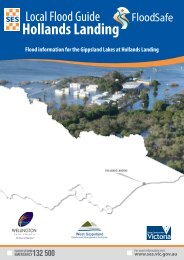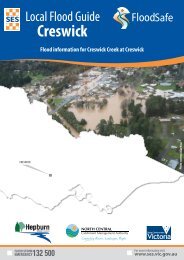Manningham - Victoria State Emergency Service
Manningham - Victoria State Emergency Service
Manningham - Victoria State Emergency Service
You also want an ePaper? Increase the reach of your titles
YUMPU automatically turns print PDFs into web optimized ePapers that Google loves.
Local Flood Guide<br />
<strong>Manningham</strong><br />
Safe<br />
Flood information for the City of <strong>Manningham</strong><br />
City of MAnningham
<strong>Emergency</strong> Broadcasters<br />
ABC Local Radio 91.1 FM<br />
Star FM 91.5FM<br />
Easymix Ten 71 AM<br />
SKY NEWS Television<br />
Local Flood Information<br />
Disclaimer<br />
This publication is presented by the <strong>Victoria</strong> <strong>State</strong> <strong>Emergency</strong> <strong>Service</strong> for the purpose of disseminating emergency<br />
management information. The <strong>State</strong> <strong>Emergency</strong> <strong>Service</strong> disclaims any liability (including for negligence) to any person<br />
in respect of anything and the consequences of anything, done, or not done of any kind including damages, costs,<br />
interest, loss of profits or special loss or damage, arising from any error, inaccuracy, incompleteness or other defect in<br />
this information. by any such person in whole or partial reliance upon the whole or part of the information in this map<br />
publication. Flood information is provided by Melbourne Water.<br />
2<br />
Local Flood Guide
Your Local Flood Information<br />
The <strong>Manningham</strong> Local Area<br />
Know your risk<br />
The City of <strong>Manningham</strong> is located 12 kilometres east of the Melbourne Central Business District and has a population of 119,190.<br />
<strong>Manningham</strong> is defined by natural water boundaries: the Yarra to the north and west, and Koonung Creek to the south. The Mullum<br />
Mullum Creek divides <strong>Manningham</strong> into two distinct areas with the west being urban in character and the east being primarily rural<br />
and residential. Essentially residential, the city has more than 1,200 hectares of open space, comprising more than 300 separate<br />
parks, gardens and reserves. The map on page two outlines the areas and river systems in <strong>Manningham</strong> and areas that may be<br />
affected during a major flood. <strong>Manningham</strong> can be affected by flooding from rivers and creeks as well as flash flooding from heavy<br />
rainfall.<br />
Flooding in <strong>Manningham</strong><br />
<strong>Manningham</strong> has a history of flash flooding. Flash flooding is<br />
defined as heavy rain over a short period of time (six hours or<br />
less) from the start of rainfall to flooding. Heavy rainfall can cause<br />
overflows from underground drains as well as localised overland<br />
flows.<br />
<strong>Manningham</strong> is hilly in nature but has many low-lying areas that<br />
are prone to flooding. There are no large water storages (e.g.<br />
dams) or large wetlands in the municipality, meaning that large<br />
pockets of water can gather in low-lying areas in the municipality<br />
before slowly draining away. In <strong>Manningham</strong>, flooding is also<br />
caused by overland flows of stormwater from heavy rainfall that<br />
exceeds the capacity of the drainage system.<br />
Flash flooding in <strong>Manningham</strong> can also result from heavy rainfall<br />
in one of the areas surrounding <strong>Manningham</strong> which then travels<br />
into the municipality and causes flooding. The best clues to what<br />
happens in the area when heavy rainfall occurs are the historical<br />
floods that have occurred in the City of <strong>Manningham</strong>.<br />
There are six main creeks in <strong>Manningham</strong>: Brushy Creek, Jumping<br />
Creek, Anderson Creek, Mullum Mullum Creek, Ruffey Creek and<br />
Koonung Creek. All six creeks direct water runoff stemming from<br />
within the municipality into the Yarra River.<br />
Did you know<br />
<strong>Manningham</strong> also has a history of flooding from the Yarra River<br />
as well as flash flooding, including:<br />
■■<br />
October 1863 - there was a great flood causing the Yarra to<br />
rise 12 metres. A number of bridges were washed away.<br />
■■<br />
October 1923 - flooding caused the Templestowe Bridge,<br />
described as “a solid wooden structure on an iron girder,<br />
with stone supports” to almost wash away. The bridge also<br />
appears to have survived the significant 1934 flood as well.<br />
■■<br />
November 2011 - 55mm of rainfall fell on Melbourne,<br />
taking the monthly rainfall total to 136mm, making it the<br />
wettest November in Melbourne since 1975. Several areas in<br />
<strong>Manningham</strong> were affected with Bulleen experiencing the<br />
most disruption.<br />
Due to the significant amount of foliage in the <strong>Manningham</strong><br />
area, storms with heavy rainfall result in flash flooding that can<br />
contain fallen branches. Floodwater is dangerous. Never drive,<br />
ride, walk or swim in floodwater - you don’t know what you’re<br />
getting into.<br />
While no two floods are the same, floods like this or worse could<br />
occur again.<br />
Local Flood Information<br />
<strong>Manningham</strong> Flood Gauges<br />
<strong>Manningham</strong> has three river gauges located on the Yarra River at<br />
different points including:<br />
■■<br />
Yarra River at Warrandyte<br />
■■<br />
Yarra River at Fitzsimmons Lane, Templestowe<br />
■■<br />
Yarra River at Banksia Street, Heidelberg<br />
Flood warnings will often give a prediction of the size of a flood<br />
based on a local gauge. In a flash flood, a warning may not be<br />
possible.<br />
What can you do<br />
Particular care is necessary in unsewered areas in <strong>Manningham</strong><br />
following a flood, as waste is likely to be carried in floodwater.<br />
Items such as waste bins, outdoor furniture and other loose<br />
materials can wash away and cause blockages to drainage pit<br />
inlets and spaces under fences, increasing the potential for<br />
flooding.<br />
Where possible, gates in the path of floodwater should be left<br />
open and loose items such as waste bins should be secured<br />
when you hear a flood warning.<br />
Local Flood Guide 3
What warnings mean<br />
Flood Watches and Flood Warnings are issued by the Bureau of<br />
Meteorology (BoM) to tell people about possible flooding.<br />
A Flood Watch means there is a developing weather pattern that<br />
might cause floods in one or two days.<br />
About Flood WarningsAbout Flood<br />
Flood Warnings mean flooding is about to happen or is already<br />
happening. There are Minor, Moderate and Major flood warnings.<br />
A Minor Flood Warning means floodwater can:<br />
■■<br />
Reach the top of the river banks<br />
■<br />
■<br />
■<br />
■<br />
■<br />
■ Come up through drains in nearby streets<br />
■ Cover low-lying areas including riverside camping areas<br />
■ Affect some low-lying caravan parks<br />
■ Cover minor roads, tracks and low level bridges<br />
■ Spread across land or go into buildings on some properties<br />
and farms.<br />
A Moderate Flood Warning means floodwater can:<br />
■■<br />
Spill over river banks and spread across low-lying areas<br />
■■<br />
Start to threaten buildings, roads, rail, power and other<br />
developments<br />
■■<br />
Require evacuation in some areas<br />
■■<br />
Cover main roads.<br />
A Major Flood Warning means floodwater can:<br />
■■<br />
Cause widespread flooding<br />
■<br />
■<br />
■<br />
■■<br />
Require many evacuations.<br />
Warnings<br />
■ Threaten many houses and businesses<br />
■ Cause properties and whole areas to be isolated by water<br />
■ Disrupt major roads and transport routes<br />
Remember, you may not receive any official warning.<br />
<strong>Emergency</strong> assistance may not be immediately available. Be<br />
aware of what is happening around you to stay safe.<br />
Never wait for a warning to act.<br />
Did you know<br />
Floodwater flows quickly and can cause vehicles to be washed<br />
away and can hide road damage and currents. Driving through<br />
floodwater is the number one cause of adult deaths during<br />
floods. NEVER walk, ride, swim or drive through floodwater.<br />
Playing in floodwater is the number one cause of death during<br />
floods for children and teenagers. Floodwater is toxic and is<br />
filled with unseen danger. NEVER allow your children to play or<br />
swim in floodwater.<br />
Warnings for the City of <strong>Manningham</strong><br />
For the Yarra River, Flood Warnings are issued by the Bureau of<br />
Meteorology.<br />
Severe storm warnings will give an indication of what to expect<br />
during the storm. If you hear a warning with flash flooding, act<br />
early and do not drive through floodwater.<br />
Flood Warnings for rivers provide predictions of flood impacts<br />
(minor, moderate or major), time and possible flow level at the<br />
various gauges. It is important to note, that you may still be<br />
affected prior to the river reaching its peak.<br />
Flash Flooding happens so quickly there may be no time<br />
to warn you. If you hear a Severe Storm Warning with flash<br />
flooding stay alert and watch out for floodwater.<br />
The <strong>Victoria</strong> <strong>State</strong> <strong>Emergency</strong> <strong>Service</strong> (SES) will give information<br />
about how the floodwater might affect people and properties.<br />
This includes safety messages to remind you what to do.<br />
Severe Thunderstorm Warnings<br />
Thunderstorms are classified as severe, due to their potential to<br />
cause significant localised damage through: wind gusts, large<br />
hail, tornadoes or flash flooding. Severe thunderstorm warnings<br />
are issued to the community by the Bureau of Meteorology.<br />
Severe Weather Warnings<br />
These warnings are issued to the community by the Bureau of<br />
Meteorology when severe weather is expected that is not directly<br />
related to severe thunderstorms, tropical cyclones or bushfires.<br />
Examples of severe weather include damaging winds, flash<br />
flooding and dangerous tides.<br />
Flash Flooding happens quickly. There may be little or<br />
no warning. The arrival time or depth of a flash flood is<br />
unpredictable.<br />
4<br />
Local Flood Guide
Preparing for Floods<br />
NOW - before a flood<br />
■■<br />
Check if your home or business is subject to flooding.<br />
■■<br />
Check if you could be cut off by floodwater.<br />
■<br />
■ Know the safest way to go if you decide to leave your property<br />
and plan an alternative route.<br />
■■<br />
Check your insurance policies to ensure your equipment,<br />
property and business are covered for flood damage.<br />
■■<br />
Keep a list of emergency numbers near the telephone.<br />
■■<br />
Develop an <strong>Emergency</strong> Plan.<br />
■■<br />
Put together an <strong>Emergency</strong> Kit.<br />
When a flood is likely<br />
■■<br />
Take action. Follow your <strong>Emergency</strong> Plan.<br />
■<br />
■<br />
■<br />
■ Listen to your radio for information and advice.<br />
■ Check your neighbours are safe and know about the flood.<br />
■ Stack possessions on benches and tables with electrical goods<br />
in the highest places.<br />
■■<br />
Anchor objects that are likely to float and cause damage.<br />
■■<br />
Move rubbish bins, chemicals and poisons to the highest<br />
place.<br />
■■<br />
Put important papers, valuables, photos and other special<br />
personal items into your <strong>Emergency</strong> Kit.<br />
■■<br />
Business owners should raise items, business records and<br />
equipment onto benches and tables.<br />
■■<br />
Rural property owners should move livestock, pumps and<br />
machinery to higher ground.<br />
■■<br />
If you are likely to be isolated, have enough food, drinking<br />
water, medicine, fuel and other needs to last at least three<br />
days.<br />
■■<br />
Do not forget pet food and stock feed.<br />
Your <strong>Emergency</strong> Plan<br />
Emergencies can happen at any time, with little warning.<br />
People who have planned and prepared for emergencies have<br />
reduced the impact and recovered faster.<br />
Taking the time to think about emergencies and make your own<br />
plan helps you think clearly and have more control to make better<br />
decisions when an emergency occurs.<br />
Your <strong>Emergency</strong> Plan should identify:<br />
Prepare a plan<br />
■■<br />
The types of emergencies that might affect you.<br />
■■<br />
How those emergencies might affect you.<br />
■<br />
■■<br />
Where to get more information.<br />
■<br />
■ What you will do before, during and after an emergency.<br />
■ Where you will go if you evacuate and the best way to go in<br />
different circumstances.<br />
■■<br />
A list of phone numbers you will need, including emergency<br />
services, your insurance company, friends and family<br />
Visit www.ses.vic.gov.au to download a copy<br />
of the Home <strong>Emergency</strong> Plan Workbook<br />
Preparing For Floods<br />
Evacuation<br />
<strong>Victoria</strong> Police is responsible for coordinating an evacuation in<br />
an emergency. During a flood, Police, SES and other emergency<br />
services may advise you to evacuate to keep you safe. It is<br />
important that you follow this advice.<br />
There are two types of evacuation notices that may be issued<br />
during a flood:<br />
■■<br />
Prepare to evacuate - means you should act quickly and<br />
take immediate action to protect your life and property. You<br />
should get ready to leave your property.<br />
■<br />
■ Evacuate immediately - you must leave immediately as there<br />
is a risk to lives.<br />
Remember you can leave at any time if you feel unsafe. You do not<br />
have to wait to be told to evacuate.<br />
Local Flood Guide 5
Home <strong>Emergency</strong> Kit<br />
<strong>Emergency</strong> Kit<br />
Every home and business should have a basic emergency kit:<br />
Copy of your <strong>Emergency</strong> Plan<br />
Radio Torch Spare batteries Copy of documents & records<br />
Long life food<br />
First aid kit<br />
Safe drinking water<br />
Gloves<br />
Check your kit often. Make sure things work. Replace out of date items.<br />
When a warning is issued, have ready for use or pack into your kit:<br />
Mobile phone and charger Prescriptions & medicines Pet needs Strong shoes Clothes for your family<br />
3 days supply<br />
3 days supply<br />
3 days supply<br />
3 days supply<br />
I need to add:<br />
Write your list here. Tick items as you pack them into your kit.<br />
Special needs<br />
Photos<br />
Family Keepsakes<br />
Valuables<br />
Documents<br />
Other<br />
6<br />
Local Flood Guide
During and After a Flood<br />
During a flood<br />
When flooding has begun:<br />
■■<br />
Never drive, ride, swim or walk through floodwater.<br />
■<br />
■<br />
■ Floodwater can be deep and damage roads and bridges.<br />
■ Do not let your children play or swim in floodwater. It is<br />
dirty, dangerous and deadly.<br />
■■<br />
Tune in to your emergency broadcasters: ABC Local Radio,<br />
Commercial Radio, designated Community Radio Stations<br />
and SKY NEWS Television.<br />
■■<br />
In life-threatening emergencies, call 000 (triple zero).<br />
■■<br />
For emergency help from the SES in floods and storms call<br />
132 500.<br />
■■<br />
Stay away from all waterways including drains and culverts.<br />
■■<br />
Stay away from fallen power lines – electricity travels easily<br />
through water.<br />
■■<br />
Be aware that animals, snakes, rats, spiders and other pests<br />
may be on the move during a flood - they may come into<br />
houses and other buildings or hide around sandbags.<br />
■■<br />
Keep in contact with neighbours.<br />
■■<br />
Be prepared to leave early.<br />
After a flood<br />
Flood dangers do not end when the water begins to fall.<br />
To make sure you stay safe:<br />
■■<br />
Keep listening to local emergency broadcasters.<br />
■■<br />
Do not return home until it is safe to do so.<br />
Once you return to your home:<br />
■■<br />
Drink bottled water or boil all drinking water until advised that<br />
the water supply is safe.<br />
■■<br />
Throw away any food or medicines that may have been in<br />
contact with floodwater or affected by power outages.<br />
■■<br />
When entering the building, use a torch to light your<br />
way - never use matches, cigarette lighters or any other flame as<br />
there may be gas inside.<br />
■■<br />
Keep the electricity and gas off until checked and tested by a<br />
professional.<br />
■■<br />
Take photographs of all damage and notify your insurer.<br />
■■<br />
Clean your home straight away to stay healthy.<br />
■■<br />
Contact Council to let them know about damage to your<br />
property.<br />
During and After a Flood<br />
When you leave early or evacuate:<br />
■■<br />
Leaving early is always the safest option, leave well before<br />
roads are closed by floodwater.<br />
■■<br />
Take your emergency kit and three days supply of clothing<br />
with you.<br />
■■<br />
Turn off the electricity, gas and water as you leave.<br />
■■<br />
Take your pets with you. Do not leave them behind. Dogs<br />
should be muzzled. Cats should be in cages.<br />
■■<br />
Go to a relief centre or to stay with friends or family in higher<br />
areas.<br />
If activated in a major flood, an <strong>Emergency</strong> Relief Centre can help<br />
you with:<br />
■■<br />
Temporary accommodation<br />
■■<br />
Financial help<br />
■■<br />
Personal support<br />
■■<br />
Drinks and meals<br />
■<br />
■<br />
■ Basic clothing and personal needs<br />
■ Help to contact family and friends.<br />
How SES helps the community<br />
The <strong>Victoria</strong> <strong>State</strong> <strong>Emergency</strong> <strong>Service</strong> (SES) is a volunteer based<br />
emergency service. Although our SES volunteers attempt to<br />
reach everyone prior to or during an emergency, at times this is<br />
not possible. Therefore it is advisable for you to be prepared for<br />
emergencies so that you can share responsibility for your own well<br />
being during those times.<br />
In a flood, SES help may include:<br />
■■<br />
Giving flood advice<br />
■■<br />
Protecting essential services<br />
■■<br />
Helping to protect infrastructure<br />
■■<br />
Rescuing people from floodwater<br />
■■<br />
Advising of an evacuation.<br />
If you choose to shelter with a friend or relative, tell authorities<br />
where you are staying.<br />
Local Flood Guide 7
Checklist and Contacts<br />
<strong>Emergency</strong> Checklist<br />
NOW: Flood preparation<br />
Check if your insurance policies cover flooding.<br />
Keep this list of emergency numbers near the telephone.<br />
Put together an <strong>Emergency</strong> Kit and prepare a home or business<br />
<strong>Emergency</strong> Plan, see www.ses.vic.gov.au.<br />
When you hear a Flood Watch or weather warning<br />
Listen to radio and check the SES website for more information<br />
and advice.<br />
Go over your <strong>Emergency</strong> Plan. Pack clothing and other extra<br />
items into your <strong>Emergency</strong> Kit and take this with you if you<br />
evacuate.<br />
Listen to severe weather warnings for flash flooding advice.<br />
Where applicable move pumps, machinery, hay and livestock to<br />
higher ground.<br />
When flooding may happen soon (a Flood Warning)<br />
Make sure your family members and neighbours are aware of<br />
what is happening.<br />
Be ready to evacuate. Act early, conditions change rapidly, roads<br />
and escape routes can be covered or blocked. Don’t forget to<br />
take pets and your medicine with you.<br />
Put household valuables and electrical items as high as possible.<br />
Turn off water, gas and electricity at the mains.<br />
Secure objects likely to float and cause damage. Raise<br />
chemicals and oils well above the predicted flood height.<br />
During the flood<br />
For emergency assistance, call 132 500 for SES.<br />
DO NOT drive, ride, swim or walk through floodwater. This is the<br />
main cause of death during floods.<br />
NEVER allow children to play in floodwater. This is the main<br />
cause of death during floods for children and young people.<br />
Stay away from drains, culverts and waterways, water can flow<br />
quickly and have strong currents.<br />
Stay well clear of fallen trees, power lines and damaged<br />
buildings.<br />
After the flood: recovery<br />
If your property has been flooded, check with <strong>Manningham</strong><br />
council for information and advice by visiting<br />
www.manningham.vic.gov.au.<br />
Have all electrical and gas equipment professionally tested<br />
before use.<br />
For more information visit:<br />
www.ses.vic.gov.au<br />
www.facebook.com/vicses<br />
www.twitter.com/vicseswarnings<br />
<strong>Emergency</strong> Contacts<br />
Life threatening <strong>Emergency</strong><br />
Police fire ambulance<br />
<strong>Victoria</strong> <strong>State</strong> <strong>Emergency</strong> <strong>Service</strong> (SES)<br />
For flood / storm emergency calls<br />
SES Information Line<br />
Operates during major floods or storms<br />
Bureau of Meteorology (BoM)<br />
Weather Information, forecasts, warnings<br />
Internet Relay users log into<br />
VicRoads<br />
Road closures and hazard reporting service<br />
City of <strong>Manningham</strong><br />
Your electricity supplier:<br />
Your gas supplier:<br />
Doctor:<br />
132 500<br />
Triple Zero<br />
TTY106<br />
1300 842 737<br />
1300 VIC SES<br />
www.ses.vic.gov.au<br />
1300 659 217<br />
www.bom.gov.au<br />
National Relay <strong>Service</strong> (NRS)<br />
www.relayservice.com.au<br />
The deaf, hearing or speech impaired can call SES or 000 using NRS:<br />
Dial Then Ask For<br />
■■<br />
Speak and Listen (SSR) users phone<br />
1300 555 727 132 500<br />
■■<br />
TTY / Voice users phone<br />
13 36 77<br />
132 500<br />
13 11 70<br />
www.vicroads.vic.gov.au<br />
Phone: 03 9840 9333<br />
Fax: 03 9848 3110<br />
Web:<br />
www.manningham.vic.gov.au<br />
Weather District:<br />
Catchment:<br />
<strong>Emergency</strong> Broadcasters<br />
<strong>Emergency</strong> broadcasters include ABC<br />
Local Radio, commercial radio stations<br />
across <strong>Victoria</strong> and SKY NEWS Television.<br />
Vet:<br />
Insurance<br />
Policy number:<br />
Phone number:<br />
Central<br />
000<br />
www.iprelay.com.au/call/<br />
then enter: 132 500 or 000<br />
Melbourne Water<br />
■■<br />
ABC Local Radio 91.1FM<br />
■■<br />
3BO 93.5 FM<br />
■■<br />
Easymix Ten 71 AM<br />
■■<br />
Easymix 98.3FM<br />
■■<br />
Star 91.9FM<br />
Complete the following and keep this information<br />
handy close to the phone:<br />
For the latest version of this publication visit www.ses.vic.gov.au EMPC-LFG-9.0 March 2013


